Global Journal of Commerce & Management Perspective
Open Access
ISSN: 2319-7285
+44 1300 500008
ISSN: 2319-7285
+44 1300 500008
Research Article - (2023)Volume 12, Issue 3
The micro, small, and medium enterprise sector are crucial to creating employment and enhancing income in developed, developing, and underdeveloped countries. In India, the micro-enterprise industry has many issues regarding finances, skills, managing enterprises, marketing, etc. The government of India introduced a free registration policy under District Industries Centres (DICs) to address these issues and promote this sector. Thousands of enterprises will register as entrepreneurs annually in different parts of India. However, after the registration, these enterprises are currently working or not whether they exist or not. There is no study on the current working status of micro-enterprises registered as micro-enterprises under the udyoga aadhaar portal in DIC. The present paper attempts to analyze the number of registered micro-enterprises under District Industries Centres (DICs) and examine the current working status of micro-enterprises. The researcher collected primary data from 84 registered micro-enterprises under the udyoga aadhaar portal in District Industries Centres (DICs) in the Gadag district of Karnataka, and secondary information from DICs and the ministry of micro, small and medium enterprises, government of India. The researcher used simple random sampling methods and cross tabulation statistics for data collection and analysis. The study found that 63 out of 84 micro-enterprises are currently working, but 21 are not existing and have closed their enterprise activity due to insufficient financial, training, and marketing assistance from DIC. The study suggests the government should evaluate DICs effectively. They should serve adequately and benefits actual beneficiaries. The aim of governments is not only to register enterprises freely under the udoyga aadhaar portal is also to preserve enterprises that have already registered.
DICs; Micro enterprises; Registered; Entrepreneurs; Cross tabulation
The micro, small and medium enterprise sector is crucial in developed, developing, and underdeveloped economies to generate employment and enhance the income of households dependent on this sector. It has lower capital investments than large industries in urban and rural areas. Entrepreneurship is the most potent weapon in the hands of one to fight against poverty and unemployment. The micro-enterprise sector is mainly a labor-intensive sector and uses local resources. In India, according to the Micro, Small and Medium Enterprises Development (MSMED) act, 2006, micro enterprises engaged in the manufacture or production, processing, or preservation of goods where investment in plant and machinery does not exceed Rs. 25 lakh. Similarly, micro enterprises engaged in providing or rendering services where the investment in equipment does not exceed Rs. 10 lakh. After 14 years, the government of India has changed the definition of micro-enterprise by announcing the policy of atmnirbhar bharat package that is micro manufacturing and services units are increased to Rs. 1 crore of investment and Rs 5 crore of annual turnover. The microenterprise industry is facing various problems such as lack of institutional finance, selling their products in the market, lack of skills, and lack of awareness about government programs, and so on [1-3]. To address these issues, the government of India initiated the District Industries Centre (DICs) policy in 1978 to promote the MSME sector by providing financial subsidies, training, and awareness about the policies and programs on the entrepreneurship development of the state or central governments. Micro enterprises can freely register their enterprises under the udyog aadhaar portal in district industries centre. Thousands of enterprises will be registered as entrepreneurs annually in different parts of India. But these registered enterprises are currently working or not after the registration whether they exist. In the review of existing studies, 82 out of 200 small and tiny industrial units, accounting for 41% of the sampled entrepreneurs, believed that the DIC (District Industry Centre) had played a valuable role in promoting industrial activity and spreading industrial culture in Madhugiri revenue sub-division in Tumkur district of Karnataka [4,5]. The government benefits under registration, such as credit, marketing, tax benefits, priority in government tenders, etc., most of the registered small manufacturing units received some government support in the pre-liberalization period. Still, a high percentage of enterprises that reported post-liberalization received no help in Durgapur, West Bengal. The main reasons were the problem of collateral required for institutional loans and harassment by bank officials. They suggested that subsidies and reservations cause distortions. The effects of a voluntary registration policy with government authorities on the financial performance of urban micro-enterprises in the Indian manufacturing sector. The author found that registered leads to significant sales and value-added per employee, and great gains are also noted for male-owned firms. Registration with government agencies is an essential determinant of financial access in the Indian small manufacturing sector. There is no study on the current working status of micro-enterprises registered as micro-enterprises under the udyoga aadhaar portal in DIC. The present study analyzes the number of registered micro-enterprises under District Industries Centres (DICs) in India and the current working status of registered microenterprises under District Industries Centre (DICs) in Gadag district of Karnataka based on primary source. The present study mainly focuses on micro-enterprises registered under the udyoga aadhaar portal in District Industries Centres (DICs). It consists of manufacturing and service micro-enterprises.
About District Industries Centres (DICs)
The District Industries Centre (DICs) policy was initiated in India on May 8, 1978, to provide an integrated administrative framework at the district level for promoting small-scale industries in rural areas. DICs are established under the department of the directorate of industries and commerce of each state. Every district has one agency to deal with all requirements of micro, small and medium industries under one roof. The needs of MSMEs are provided and supported by DICs. The primary function of DICs is to act as the chief coordinator or multifunctional agencies in respect of various government departments and other agencies. The prospective small entrepreneur will obtain assistance from this organization for setting up and running the industry in rural areas.
Objectives of DICs-To issue udyog aadhaar memorandum for enterprises, to provide subsidies, to help the entrepreneurs in marketing their products, to conduct training and entrepreneurship development programs, to provide awareness about the policies and programs on the industrial development of the state or central governments through seminars and dissemination meets, to provide financial assistance [6].
Brief profile about the study area
Karnataka state is fifth place in the country in industrial growth, and it has more than 4 lakh crore investments and 55 lakh people employment in the state MSME sector. Gadag is one of the districts of the Karnataka state, and it has an industrial area in Narasapura with 165.75 acres of land and six industrial estates Gadag, Betageri, Ron, Gajendragad, Lakshmeshwar, and Mundaragi. It has included a total of 56.53 acres of industrial estate land.
The researcher collected the primary data from micro-enterprises registered under the udoyga aadhaar portal in the district industries centre in the Gadag district of Karnataka. The 84 samples of micro-enterprises have included the manufacture of food products, textiles, leather products, electrical equipment, plastic paper and cups, bricks, agarbatti and in services computer centers, xerox centers, mobile repair and service shops, auto and travel service, photo studio, and grocery shops have been collected during Jun and July month of 2022 by contacting phone. DIC provided 500 enterprises' contact mobile numbers, names, and addresses. We surveyed through a questionnaire and used a simple random sampling method for data collection. In this population, 84 samples have been chosen based on Slovin's formula, which Slovin formulated to calculate the sample size in 1960.
Slovin's formula:

n=Sample size
N=Population size
e=Margin of error
The secondary data has been collected from the ministry of micro, small and medium enterprises, the government of India, and the state/UT commissionerates/directorates of industries and Micro, Small and Medium Enterprises (MSMEs) development institutes. The cross tabulation statistics were used for data analysis using the SPSS program [7].
Analysis and data interpretation
Table 1 shows state-wise registered micro-enterprises under the udyoga aadhaar portal in DIC in India from 2015 to 2020. The 39.49% micro manufacturing and 60.51% micro service enterprises are registered in a total number of micro-enterprises. The Maharastra state has the highest number of micro-enterprises. It is followed by Tamil Nadu, Madya Pradesh, Bihar, Uttar Pradesh, and Gujarat. Similarly, Ladakh, Lakshadweep, and Sikkim have lower enterprises.
| States | Manufacturing micro-enterprises | Manufacturing micro-enterprises in percentage | Service micro-enterprises | Service micro-enterprises in percentage | Total number of micro-enterprises | Total in percentage |
|---|---|---|---|---|---|---|
| Andaman and Nicobar Islands | 1816 | 0.05 | 3354 | 0.06 | 5170 | 0.06 |
| Andhra Pradesh | 107352 | 3.03 | 214306 | 3.95 | 321658 | 3.59 |
| Arunachal Pradesh | 657 | 0.02 | 498 | 0.01 | 1155 | 0.01 |
| Assam | 12502 | 0.35 | 9410 | 0.17 | 21912 | 0.24 |
| Bihar | 311835 | 8.81 | 592315 | 10.92 | 904150 | 10.09 |
| Chandigarh | 3392 | 0.1 | 7144 | 0.13 | 10536 | 0.12 |
| Chhattisgarh | 16543 | 0.47 | 48435 | 0.89 | 64978 | 0.73 |
| Dadra and Nagar Haveli | 1444 | 0.04 | 2156 | 0.04 | 3600 | 0.04 |
| Daman and Diu | 945 | 0.03 | 939 | 0.02 | 1884 | 0.02 |
| Delhi | 73550 | 2.08 | 89597 | 1.65 | 163147 | 1.82 |
| Goa | 2750 | 0.08 | 4453 | 0.08 | 7203 | 0.08 |
| Gujarat | 388658 | 10.98 | 340833 | 6.29 | 729491 | 8.14 |
| Haryana | 73730 | 2.08 | 95720 | 1.77 | 169450 | 1.89 |
| Himachal Pradesh | 4815 | 0.14 | 7139 | 0.13 | 11954 | 0.13 |
| Jammu and Kashmir | 2531 | 0.07 | 5783 | 0.11 | 8314 | 0.09 |
| Jharkhand | 49511 | 1.4 | 102247 | 1.89 | 151758 | 1.69 |
| Karnataka | 154742 | 4.37 | 178608 | 3.29 | 333350 | 3.72 |
| Kerala | 67413 | 1.9 | 52345 | 0.97 | 119758 | 1.34 |
| Ladakh | 53 | 0 | 27 | 0 | 80 | 0.001 |
| Lakshadweep | 55 | 0 | 42 | 0 | 97 | 0.001 |
| Madhya Pradesh | 306605 | 8.66 | 604254 | 11.14 | 910859 | 10.16 |
| Maharashtra | 522791 | 14.77 | 1216773 | 22.44 | 1739564 | 19.41 |
| Manipur | 19800 | 0.56 | 12085 | 0.22 | 31885 | 0.36 |
| Meghalaya | 1448 | 0.04 | 678 | 0.01 | 2126 | 0.02 |
| Mizoram | 1658 | 0.05 | 938 | 0.02 | 2596 | 0.03 |
| Nagaland | 906 | 0.03 | 611 | 0.01 | 1517 | 0.02 |
| Odisha | 40052 | 1.13 | 76365 | 1.41 | 116417 | 1.3 |
| Puducherry | 3927 | 0.11 | 5518 | 0.1 | 9445 | 0.11 |
| Punjab | 80890 | 2.29 | 115544 | 2.13 | 196434 | 2.19 |
| Rajasthan | 226815 | 6.41 | 320608 | 5.91 | 547423 | 6.11 |
| Sikkim | 270 | 0.01 | 431 | 0.01 | 701 | 0.01 |
| Tamil Nadu | 444551 | 12.56 | 524668 | 9.68 | 969219 | 10.81 |
| Telangana | 77918 | 2.2 | 161572 | 2.98 | 239490 | 2.67 |
| Tripura | 2940 | 0.08 | 2675 | 0.05 | 5615 | 0.06 |
| Uttar Pradesh | 407147 | 11.5 | 478017 | 8.81 | 885164 | 9.88 |
| Uttarakhand | 16810 | 0.47 | 22873 | 0.42 | 39683 | 0.44 |
| West Bengal | 110700 | 3.13 | 123939 | 2.29 | 234639 | 2.62 |
| India | 3539522 | 39.49 | 5422900 | 60.51 | 8962422 | 100 |
Table 1: State-wise registered micro enterprises under udyoga aadhaar portal in DICs in India (October 2015 to June 2020).
Table 2 discloses year-wise registered micro-enterprises in DICs in Karnataka state and Gadag district from 2007 to 2015. It reveals that the number of registered micro-enterprises is increasing year by year (Figure 1).
| Year | Registered micro-enterprises in Karnataka | Registered micro-enterprises in Gadag |
|---|---|---|
| 2007-2008 | 14049 | 221 |
| 2008-2009 | 14812 | 219 |
| 2009-2010 | 16177 | 235 |
| 2010-2011 | 17408 | 276 |
| 2011-2012 | 19610 | 280 |
| 2012-2013 | 22185 | 298 |
| 2013-2014 | 23229 | 311 |
| 2014-2015 | 26002 | 359 |
| Total | 153472 | 2199 |
Table 2: Registered micro-enterprises in DICs in Gadag district of Karnataka.
Table 3 depicts the results of the current working status of enterprises and gender cross tabulation using the SPSS program. Male entrepreneurs more than females. 46 male and 17 female entrepreneurs of 84 who involved in the manufacturing of textile, food products, plastic paper and cups, wood works, leather-related products, and servicing of computer centers, photo studios, auto and travel service, hair salons, tailoring, beauty parlor activities are currently working, and 16 male and five female entrepreneurs of 84 involved in manufacturing of textile, bricks, food products, leather related products, agarabatti, plastic paper and cups, and service of small hotels, readymade cloth shops, computer centers do not exist [8]. During the survey, enterprises that did not exist recently informed that during the COVID pandemic, many micro-enterprises could not manage their business activities amid the announced lockdown across the country, which commonly affected all sectors (Figure 2).
| Variables | Gender | Total | |||
|---|---|---|---|---|---|
| Male | Female | ||||
| Current working status of enterprises | Yes | Count | 46 | 17 | 63 |
| % of total | 54.80% | 34.50% | 75.00% | ||
| No | Count | 16 | 9 | 21 | |
| % of total | 19.00% | 10.70% | 25.00% | ||
| Total | Count | 46 | 62 | 84 | |
| % of total | 54.80% | 73.80% | 100.00% | ||
Table 3: Current working status of enterprises and gender cross tabulation.
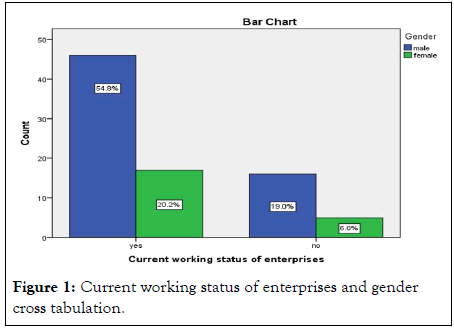
Figure 1: Current working status of enterprises and gender cross tabulation.
Table 4 indicates 34 manufacturing and 29 service microenterprises of 84 currently running, and 12 manufacturing and nine service micro-enterprises are not working. In our survey, manufacturing enterprises are more than services (Table 5). Mainly, manufacturing enterprises are facing a lack of raw materials, an owner of the enterprise who manufactured plastic paper plates and cups imported machine tools and raw materials from Chennai, but the market price is low for his products and lack of labour he could not continue his enterprise (Figure 2). Therefore, he closed the enterprise. Another entrepreneur who manufactured a photo framework faced a lack of demand for his products, and it was not easy to operate against modern digital flex [9].
| Variables | Type of micro-enterprises | Total | |||
|---|---|---|---|---|---|
| Manufacturing | Service | ||||
| Current working status of enterprises | Yes | Count | 34 | 29 | 63 |
| % of total | 40.50% | 34.50% | 75.00% | ||
| No | Count | 12 | 9 | 21 | |
| % of total | 14.30% | 10.70% | 25.00% | ||
| Total | Count | 46 | 38 | 84 | |
| % of total | 54.80% | 45.20% | 100.00% | ||
Table 4: Current working status of enterprises and type of micro-enterprises cross tabulation.
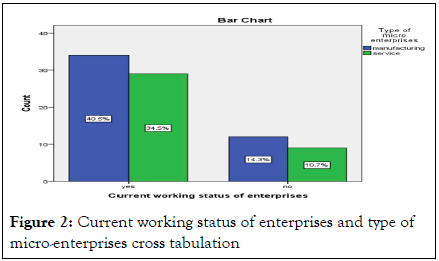
Figure 2: Current working status of enterprises and type of micro-enterprises cross tabulation
Table 5 shows the results of the cross tabulation between the current working status of enterprises and the education level of entrepreneurs using the SPSS program. Most entrepreneurs studied secondary school and pre-university courses (Figure 3).
| Variables | Education level | Total | ||||||
|---|---|---|---|---|---|---|---|---|
| Lower primary | Higher primary | Secondary school and PUC | Undergraduate | Postgraduate | ||||
| Current working status of enterprises | Yes | Count | 7 | 9 | 33 | 12 | 2 | 63 |
| % of total | 8.30% | 10.70% | 39.30% | 14.30% | 2.40% | 75.00% | ||
| No | Count | 1 | 7 | 11 | 2 | 0 | 21 | |
| % of total | 1.20% | 8.30% | 13.10% | 2.40% | 0.00% | 25.00% | ||
| Total | Count | 8 | 16 | 44 | 14 | 2 | 84 | |
| % of total | 9.50% | 19.00% | 52.40% | 16.70% | 2.40% | 100.00% | ||
Table 5: Current working status of enterprises and education level cross tabulation.
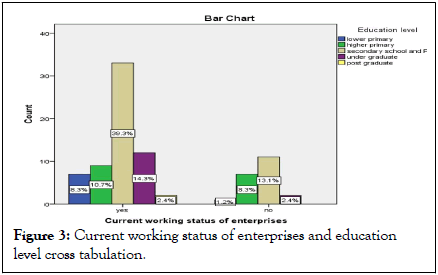
Figure 3: Current working status of enterprises and education level cross tabulation.
Table 6 reveals 54 urban micro-enterprises and 30 rural micro-enterprises in total 84 enterprises. Urban enterprises are more than rural enterprises, and even currently working or running urban enterprises are more than rural enterprises (Figure 4).
| Variables | Locale of enterprises | Total | |||
|---|---|---|---|---|---|
| Urban | Rural | ||||
| Current working status of enterprises | Yes | Count | 43 | 20 | 63 |
| % of total | 51.20% | 23.80% | 75.00% | ||
| No | Count | 11 | 10 | 21 | |
| % of total | 13.10% | 11.90% | 25.00% | ||
| Total | Count | 54 | 30 | 84 | |
| % of total | 64.30% | 35.70% | 100.00% | ||
Table 6: Current working status of enterprises and Locale of enterprises cross tabulation.
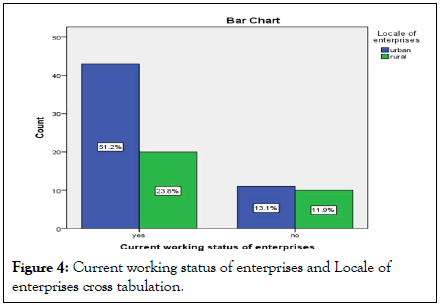
Figure 4: Current working status of enterprises and Locale of enterprises cross tabulation.
Table 7 presents the working period of enterprises. 89.3% of micro-enterprises rely on full-time. Only 10.7% are working part-time [10,11]. 66.7% of micro-enterprises involved in full-time currently exist in a total of 89.3%, and 8.3% of micro-enterprises engaged in part-time live in a total of 10.7% (Figure 5).
| Variables | The working period of enterprises | Total | |||
|---|---|---|---|---|---|
| Part time | Full time | ||||
| Current working status of enterprises | Yes | Count | 7 | 56 | 63 |
| % of total | 8.30% | 66.70% | 75.00% | ||
| No | Count | 2 | 19 | 21 | |
| % of total | 2.40% | 22.60% | 25.00% | ||
| Total | Count | 9 | 75 | 84 | |
| % of total | 10.70% | 89.30% | 100.00% | ||
Table 7: Current working status of enterprises and working period of enterprises cross tabulation.
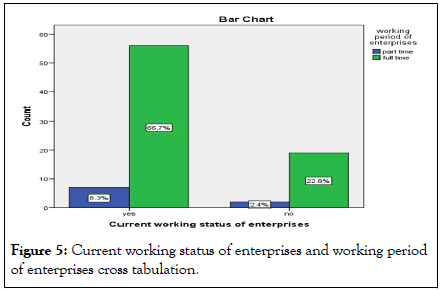
Figure 5: Current working status of enterprises and working period of enterprises cross tabulation.
Table 8 shows the social status of enterprises. It consists of four communities, enterprises that belong to the OBC community registered more than others. ST community enterprises are very few (Figure 6).
| Variables | Social status | Total | |||||
|---|---|---|---|---|---|---|---|
| SC | ST | OBC | General | ||||
| Current working status of enterprises | Yes | Count | 16 | 4 | 33 | 10 | 63 |
| % of total | 19.00% | 4.80% | 39.30% | 11.90% | 75.00% | ||
| No | Count | 1 | 3 | 14 | 3 | 21 | |
| % of total | 1.20% | 3.60% | 16.70% | 3.60% | 25.00% | ||
| Total | Count | 17 | 7 | 47 | 13 | 84 | |
| % of total | 20.20% | 8.30% | 56.00% | 15.50% | 100.00% | ||
Table 8: Current working status of enterprises and social status cross tabulation.
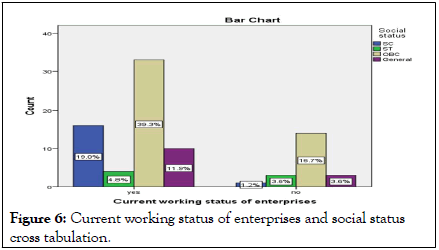
Figure 6: Current working status of enterprises and social status cross tabulation.
Table 9 reports the results of the cross tabulation using the SPSS program between the current working status of enterprises and the age group of entrepreneurs. 36 of 84 micro-entrepreneurs are more than others in the age group of 31 to 40. Even this age group of entrepreneurs is more currently existing than others. It represents young people working in the micro-enterprise sector (Figure 7).
| Variables | Age group of entrepreneur | Total | ||||||
|---|---|---|---|---|---|---|---|---|
| below 30 | 31 to 40 | 41 to 50 | 51 to 60 | above 60 | ||||
| Current working status of enterprises | Yes | Count | 10 | 27 | 21 | 3 | 2 | 63 |
| % of total | 11.90% | 32.10% | 25.00% | 3.60% | 2.40% | 75.00% | ||
| No | Count | 1 | 9 | 8 | 3 | 0 | 21 | |
| % of total | 1.20% | 10.70% | 9.50% | 3.60% | 0.00% | 25.00% | ||
| Total | Count | 11 | 36 | 29 | 6 | 2 | 84 | |
| % of total | 13.10% | 42.90% | 34.50% | 7.10% | 2.40% | 100.00% | ||
Table 9: Current working status of enterprises and age group of entrepreneur cross tabulation.
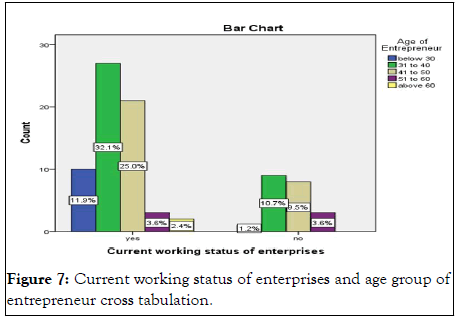
Figure 7: Current working status of enterprises and age group of entrepreneur cross tabulation.
The micro-enterprise sector is the economic backbone of households. Since the free registration policy was introduced in India, the registration process has rapidly increased. During 2015-2020, 89,62,422 micro-enterprises, i.e., 39.49% micro-manufacturing and 60.51% micro service enterprises, were registered under the udayma aadhaar portal in India. It seems service enterprises more than manufacturing enterprises. In state-wise registered enterprises, Maharashtra state had the highest number of registered micro manufacturing and service enterprises in India. The 84 samples of enterprises have been collected from the Gadag district of Karnataka to study the current working status of micro-enterprises. We found that 63 out of 84 enterprises are currently working, but 21 are not existing. Our survey included the manufacture of food products, textiles, leather products, electrical equipment, plastic paper and cups, bricks, agarbatti, photo frameworks, wood works and in services computer centers, xerox centers, mobile repair shops, auto and travel services, photo studio, and grocery shops, hair salon shops, beauty parlor, small hotels, readymade cloth shops. Male entrepreneurs more than females, with 46 male and 17 female entrepreneurs of 84 involved in the manufacturing of textile, food products, plastic paper and cups, wood works, leather-related products, and servicing of computer centers, photo studios, auto and travel service, hair salons, tailoring, beauty parlor activities are currently working, and 16 male and five female entrepreneurs of 84 involved in manufacturing of textile, bricks, food products, leather related products, agarabatti, plastic paper and cups, and service of small hotels, readymade cloth shops, computer centers do not exist. During the survey, enterprises that did not exist recently informed that during the COVID pandemic, many micro-enterprises could not manage their business activities amid the announced lockdown across the country, which commonly affected all sectors. In our study, manufacturing enterprises are more than services. Mainly, manufacturing enterprises are facing a lack of finance, lack of skill, and lack of raw materials.
An enterprise owner who manufactured plastic paper plates and cups imported machine tools and raw materials from Chennai, and market prices were low for his products and lack of labour, he could not continue his enterprise and closed the enterprise. An enterprise with a flour mill and two workers needed finance to replace old machinery and registered his enterprise in DIC to get financial assistance. Still, he did not get aid from DIC and closed his mill and started a small grocery shop with no workers. Another entrepreneur who manufactured a photo framework faced a lack of demand for his products, and it was not easy to operate against modern digital flex. Now, he is working in the agriculture sector as a worker. Most enterprises are engaged full-time, and only a few in part-time, 89.3% of micro-enterprises rely on full-time, and only 10.7% are working part-time. Enterprises that belong to the OBC community registered more than others. ST community enterprises are very few. 36 of 84 micro-entrepreneurs are more than others in the age group of 31 to 40. Even this age group of entrepreneurs is more currently existing than others. Young people are working in the microenterprise sector.
As per the above results, the micro-enterprise sector has many issues such as lack of finance, lack of skills, lack of labour, lack of raw materials, lack of enterprise managing skills, and lack of awareness about government policies. Especially during the COVID pandemic, many enterprises could not continue their activities. Hence, they closed and worked as workers in the agriculture and construction sector, and some manufacturing units turned to services. The government introduced the DICs policy to address enterprise issues and to provide financial assistance, training, and marketing assistance. These are significant objectives of DICs. We suggest government evaluate DICs effectively, and they should serve appropriately and benefit actual beneficiaries. The aim of governments is not only to register enterprises freely under the udyoga aadhaar portal but also to preserve enterprises that have already registered. It should take improvements under the DIC policy to survive entrepreneurship because many young people are involved in this sector.
[Google Scholar] [PubMed]
Citation: Bhajantri H (2023) A Statistical Analysis of Working Status of Micro-Enterprises in District Industries Center of Gadag, Karnataka. Global J Comm Manage Perspect. 12:032.
Received: 04-Jan-2023, Manuscript No. GJCMP-23-21265; Editor assigned: 06-Jan-2023, Pre QC No. GJCMP-23-21265 (PQ); Reviewed: 20-Jan-2023, QC No. GJCMP-23-21265; Revised: 20-Mar-2023, Manuscript No. GJCMP-23-21265 (R); Published: 27-Mar-2023 , DOI: 10.35248/2319-7285.23.12.032
Copyright: © 2023 Bhajantri H. This is an open-access article distributed under the terms of the Creative Commons Attribution License, which permits unrestricted use, distribution, and reproduction in any medium, provided the original author and source are credited.